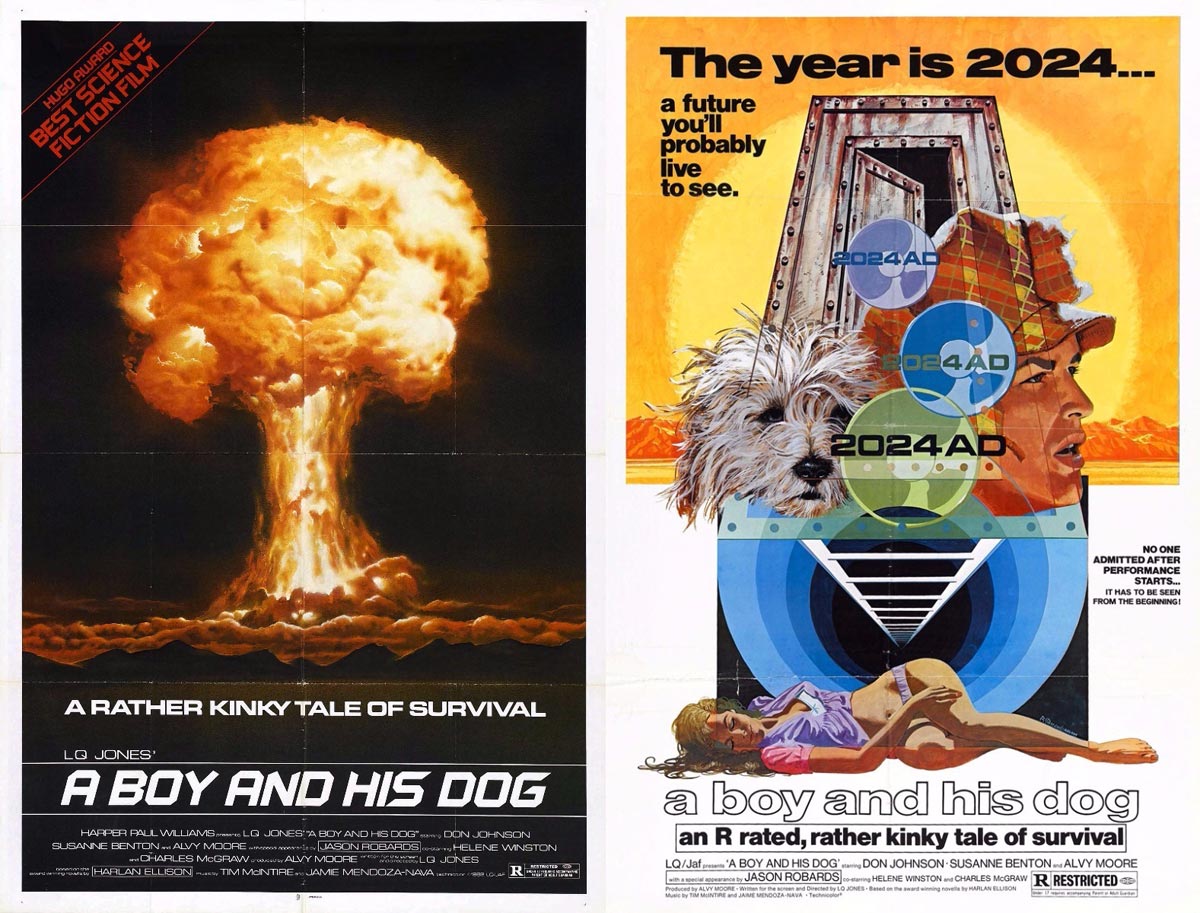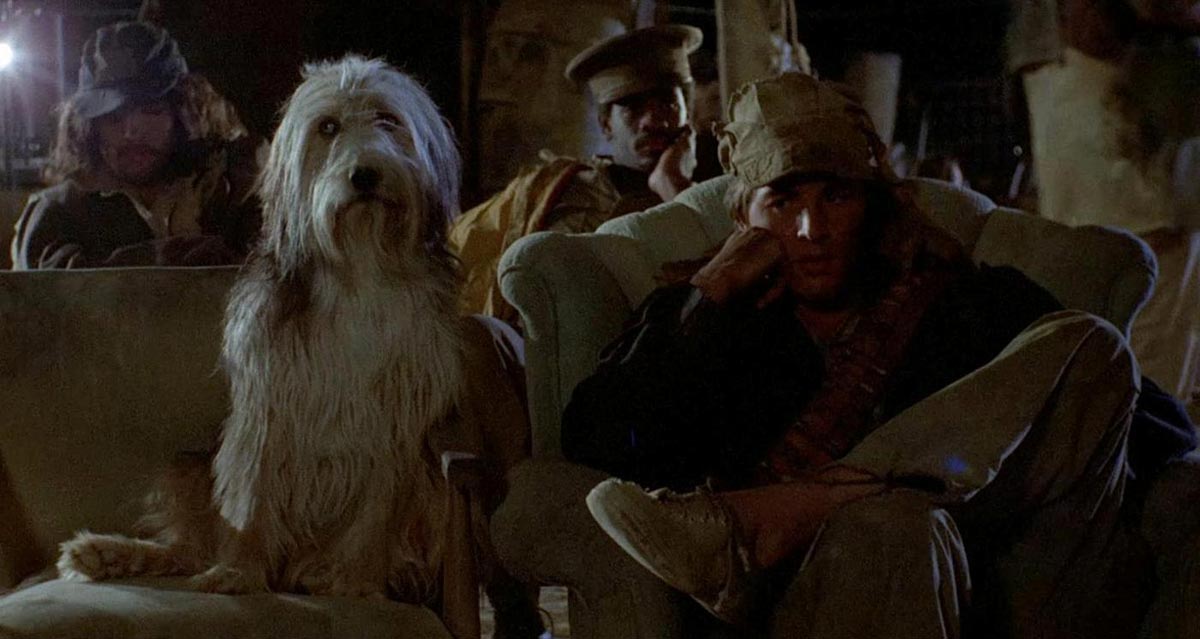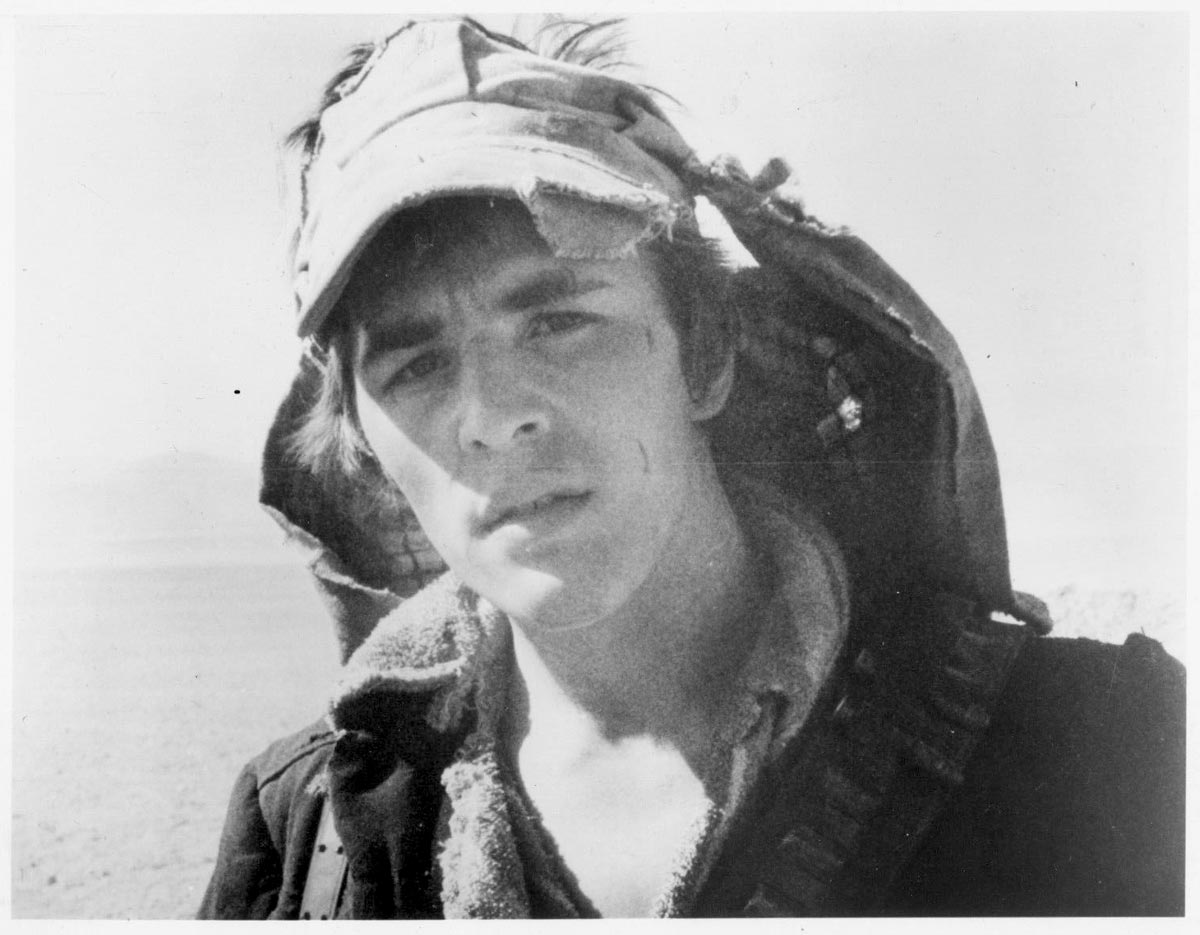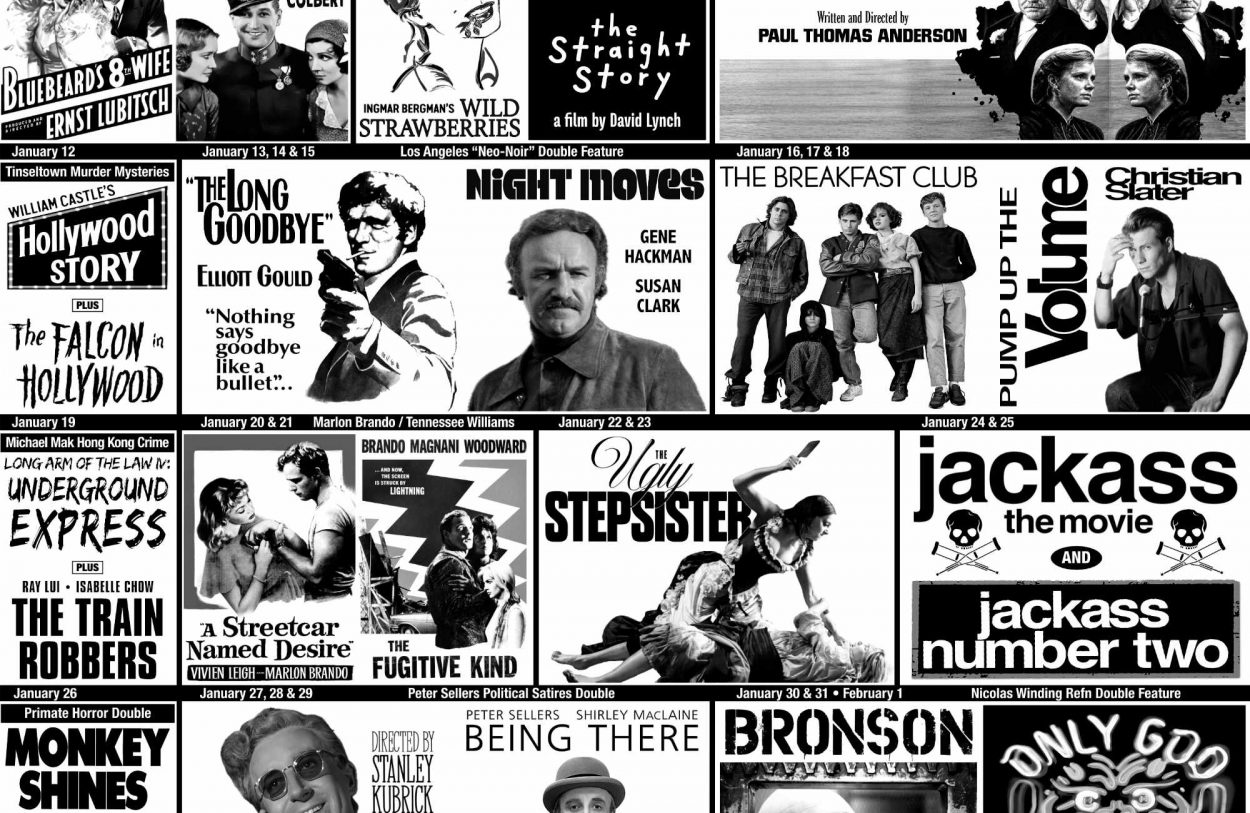“I gotta get back in the dirt so I can feel clean!”
So let’s timeline the beginnings of Post-Apocalyptic Sci-Fi Films:
In 1975, LQ Jones directs (and writes the screenplay for) the Harlan Ellison-penned A Boy and His Dog, which you will be able to see at midnight on June 3rd at the New Beverly.
Jack Smight rocks the house in 1977 with his Damnation Alley, which includes some truly awesome survival vehicles and special effects design. This film is playing this month at the Bev, on June 20th.
Then comes a film that you may all be highly familiar with: George Miller’s first entry into the franchise that guaranteed his film legacy, Mad Max, released in 1979 and highly influenced by the previously discussed two films. His second film in this series, Road Warrior (1981), plays June 2 & 3 as part of one of the most killer double features you’ll ever see.
Because of these films that broke that dusty, desert ground, a tidal wave of great genre work exploded on the scene. It came from everywhere: literature, comic books, you name it. Films like The New Barbarians aka Warriors of the Wasteland (Enzo Castellari, 1983), Steel Dawn (Lance Hool, 1987), Hardware (Richard Stanley, 1990) and Tank Girl (Rachel Talalay, 1995) are just a few titles that sprang forth from this rich soil of the Post-Apocalyptic Wasteland Cinema Garden.

So what was up with this first film? How does a movie about a horny kid with a psychic connection to his dog end up birthing a genre? How did A Boy and His Dog literally change the science fiction film landscape? To the uninitiated, this film’s narrative certainly retains the flavor of what is generally regarded as a cult classic. The unconventional characters, overtly sexual dynamics, uncomfortable themes of authoritarianism/control and extreme aesthetics were (and are) all common traits of cult films. However, these are also common tropes within the literature of author, Harlan Ellison. Ellison simply states, “This film [A Boy and His Dog] was 20 years ahead of its time. The fact that it’s been ripped off so many times to do this kind of dystopian future, both in novels and film, shows … that this film was a landmark. I had George Miller call me from Australia to tell me The Road Warrior was ripped off – and he used the phrase “ripped off” – from A Boy And His Dog, and that he wanted to thank me. But Road Warrior is a great movie. Many of the people who have done films like A Boy And His Dog have done homages whether they care to admit it or not, and I’m down with that. It’s part of being a great silver-maned icon of 20th-century culture.”
Ellison remains a giant in his field. If you have been lucky enough to be at the New Beverly during any of the times that this quick-witted and sharp-tongued man has visited, you would know what an incredible experience it is to be in his presence. To read his work is to drop into a whole other universe. But dropping into that universe does not mean dropping out of your own. Harlan Ellison writes extremely pointed work. It is smart and every. Single. Word. Matters. One of the reasons that BAHD was a groundbreaking work cinematically is because Ellison is a pioneering author, period. While much of his work may fall into the science fiction category, he is not a science fiction writer.
I began to read his work in college; after his name was tossed around enough times by people I knew were “in the know.” One of the things that drew me in so deeply was the heady and intoxicating mix of horror, criminality and offbeat narratives, similar to my precious and holy Twilight Zone. I wouldn’t find out until way later that Ellison served as the creative consultant for the 1980s version OF the Twilight Zone and wrote scripts for The Alfred Hitchcock Show! No wonder his work hit my literary taste buds just right! I’m not sure you have to know Harlan Ellison to appreciate him. But you have to appreciate the work he puts into his craft.
The production and exhibition of this film could not be more fascinating (although the cast and crew gives it a run for its money). While Ellison was initially supposed to write the screenplay, those duties ended up going to L.Q. Jones, director of the picture and (subsequently) screenwriter. According to reports, it took Jones a year to complete the screenplay, writing at night while maintaining his acting career by day. Filming locations included Barstow and Pacific Ocean Park in Venice, CA and total principal photography was completed between April and May of 1973. This film was no studio film. Although a major studio had tried to buy the screenplay, L.Q. Jones had basically refused, asking for $1 million and 90% of the film’s gross (!!). Instead, Jones financed the $400,000 budget independently.
Because he had worked with him previously in Men in War (Anthony Mann, 1957) and The Wild Bunch (Sam Peckinpah, 1969), L.Q. Jones had Robert Ryan in mind for the part of Lou Craddock. Sadly, Bob was stricken with cancer before he was able to play the role so it went to Jason Robards. It was harder to find the protagonist, Vic. According to Jones, “we did over 600 tests with men for the part, before we found Don [Johnson]. It was a tough role – as an actor you don’t want to get into a scene with a child or a dog. He had to act with a dog that talked that was smarter than him. There’s no doubt in my mind that’s the best thing he ever did and he ever will do.” Apparently, they found Tiger, the dog that played Blood, almost immediately. And if he looks familiar – it’s because you saw him on a few episodes of The Brady Bunch! He’s a real acting pro, that pup!

The story follows Vic (Don Johnson) and his companion Blood (Tiger) as they travel across the post-apocalyptic wasteland in search of food and (for Vic) women. Blood and Vic have a psychic connection and Blood has a, um, special “gift” for being able to sense danger, women and other things. While this may seem slightly weird or misogynistic (especially given that some of the initial dialogue has definite shock value), the story itself does not swing that way. It’s smarter and more complex. While one of the taglines is “A Rather Kinky Tale of Survival,” the other one, “The Year is 2024, a Future You’ll Probably Live to See,” seems much more applicable.
As the Canine/Human Team journey forth, I argue that the hypersexuality of the narrative undercuts any kind of individual agency and shifts our concerns to a mutual concern for our freedom to have sexual desires of our own, male, female or anything in between. When Vic (Don Johnson) descends into the Underworld to search for the one woman he has found (and seems to care for), Quilla June (Susanne Benton), he is confronted by a society structured completely on the past. It is heterosexual patriarchy running rampant and taken to the extreme – thus translated to de-personalizing people and re-identifying them as breeding machines. This is a science fiction film but it’s also a horror film. Everything that occurs below the surface area (where Vic and Blood had been surviving) is nightmarish and ghoulish.
The exhibition of A Boy and His Dog is a story in and of itself. It ran regularly for seven years at repertory houses, until it had a general re-release in 1982. The box office was more than $6 million to that time, plus $900,000 from “recent test re-runs” nationwide. Due to Jones’ independence on the picture it was also primarily distributed in that manner. He advertised and spread the word about A Boy and His Dog and then dealt with the theaters from those actions. When bookings would come in, Jones or a representative for him would go to the theater inquiring about the screening and do a full inspection – projection booth, theater, the works – before agreeing to the deal.

[POSSIBLE SPOILERS BELOW]
One final point necessary for any BAHD discussion is that of film/literary adaptations. While many hold the belief (and strongly so) that “the book is always better than the film,” it is hard to do this with Ellison since he has written so much visual media! On a personal level, I have always said that it’s apples and oranges. Different textures, both fruit. Literature and visual media are equally enjoyable for different reasons. They hold different powers and abilities for expression. It’s not fair to compare them. But BAHD has a compelling argument written in the last line that truly changes the feel of the film versus the novella.
In A Boy and His Dog, the final line of dialogue was written by L.Q. Jones and thus was not from the novella. It also really changed the tone of the finale. Harlan Ellison has repeatedly expressed his dislike of that line and his feelings make sense. While the film is most certainly a dark comedy and quite funny in many areas, I think it would be wrong not to recognize Ellison’s feelings on the matter. He is a man who worked hard for social change and feels strongly about his carefully phrased literature.
Ellison’s initial response was that this was a “moronic, hateful chauvinist last line, which I despise.” While his current feelings still maintain this, he has clarified why. In a recent article, Harlan explicated, “Frat boys leap to their feet and applaud and love it to this day. People batten on that line. They love it. I’m still uncomfortable with it, as I would be with, say, the N-bomb word, although I’ve used it many times, because it was what was necessary for a story. Or the F-word. I don’t think that line, in these times, is any more comfortable for me than when it first came out. I had terrible trouble with – I would go to colleges, and women’s groups would rise and scream at me from the audience, and I’d have to sit down with them and explain to them that this was not I, but L.Q. speaking. And I don’t make apologies for L.Q. He knew what he was doing for his audience.”
Here are the two lines for comparison:
FILM – Blood: Well I’d say she certainly had marvelous judgment, Albert, if not particularly good taste
STORY – “We had to move slow because Blood was still limping. It took a long time before I stopped hearing her calling me in my head. Asking me, asking me: Do you know what love is? Sure I know. A boy loves his dog.”
In context, the L.Q. Jones line is humorous but absolutely horrific. It’s insane and tragic at the same time, almost mirroring the two beings’ situation. It’s a kind of Gallows’ Humor, to be sure. And you may laugh at it. That’s fair. But I agree with what Ellison has to say about the alteration and it strikes deep. When it comes to the final action of the film and how it is dealt with in that line (and this is very important in this film) what is the feeling the audience should be left with? The L.Q. Jones one, which, while funny, is playing on misogyny and hate or the Ellison-penned one which is more complex, drawing on survival instincts and companionship beyond sex?
Decide for yourself in this groundbreaking and fantastic midnight movie, only at the New Beverly in June!


